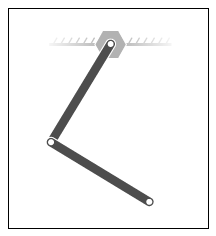DoubtExplanation of doubt 1:
Consider a double pendulum made up of two massive rods. Here there are two degrees of freedom and hence two generalized coordinates. Assume that 5 separate non-constraint (applied) forces act on this system of double pendulum: ${\vec {F_1}}$ and ${\vec {F_2}}$ on the upper rod (rod 1) and ${\vec {F_3}}, {\vec {F_4}}$ and ${\vec {F_5}}$ on the lower rod (rod 2). Now ${\vec {F_1}}$ and ${\vec {F_2}}$ can be replaced (hypothetically) by a single force ${\vec {F_A}}$ which produces the same effect as ${\vec {F_1}}$ and ${\vec {F_2}}$ combined (as taught in undergrad physics courses). Similarly the three forces on rod 2 can be replaced by a single force ${\vec {F_B}}$. Hence, finally we have the number of forces just equal to the no. of degrees of freedom (no. of generalized coordiantes).
I can't think of a way of reducing the no. of forces further.
DoubtExplanation of doubt 2:
Let's hope that the author meantmeans 'impressed' or 'non-constraint' or 'applied' force when he says 'external' force.

